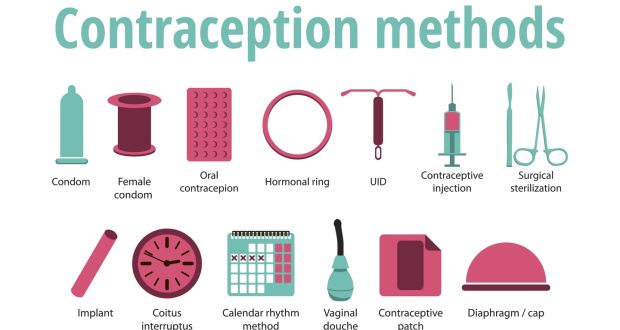Contraception is the process of preventing pregnancy using different methods. Unprotected sexual intercourse may lead to unwanted pregnancy and sexually transmitted infections.
More than 15 million girls between 15 and 19 give birth every year worldwide while an additional 5 million have abortions. Contraceptive use helps individuals to decide freely and responsibly if, when and how many children they wish to have.
Different methods of contraception have been used for thousands of years by both men and women in a bid to plan families by controlling fertility. There are many methods of contraception today which vary in their effectiveness, delivery and use as well as the mechanism they work by. Some contraceptives may only be used when prescribed by a doctor while others do not need medical advice.
Contraceptives are either barrier methods (e.g. condoms), or hormonal methods (e.g. oral contraceptive pills). When selecting a method, one’s sexual relationship(s), sexual behaviours engaged in, frequency of intercourse, risk of sexually transmitted illness, efficacy of the contraceptive method, ability to comply with use, ability to tolerate side-effects, cost, convenience, religious beliefs, partner(s) attitudes, and additional personal factors that may influence the decision and method compliance must be considered.
The following are available contraceptive options:
1. Coitus interruptus (withdrawal method): This method of contraception does not require any supervision or medical advice. However, it is unreliable as it requires the removal of the penis from the vagina before ejaculation. Additionally, pre-ejaculatory secretions (pre-cum) may contain millions of sperm cells. It is the least effective method of contraception and does not prevent sexually transmitted illnesses.
2. Condoms: Condoms are available for both men and women. The male condom is placed on the erect penis before the start of sexual intercourse. The female condom is inserted in the vagina before intercourse and removed after. They are easy to use, very effective, affordable and easily accessible. They may, however, cause allergic reactions in some people, may cause reduced sensitive, maybe worn wrongly and may also burst or slip off during sex. Condoms cannot be reused.
3. Diaphragm: This is a device that is inserted in the vagina before the onset of sex. It is similar to a condom in its mechanism and protects against sexually transmitted infections. Diaphragms also contain spermicides (materials that kill sperm cells). They may protect against some sexually transmitted infections and are very effective. They are, however, required to be fitted by a medical professional before sexual intercourse and also left in place for a period after sexual intercourse.
4. Intrauterine Contraceptive Devices (IUCDs or IUDs): These are contraceptive materials made of plastic or metallic materials, with hormones on them inserted into the uterus. They work by interfering with the movement of sperm cells and preventing implantation. They are typically long-acting (lasts between 5 to 10 years), very effective and allow a prompt return to fertility after removal. They, however, do not protect against sexually transmitted illnesses. They may also cause some side effects and complications.
5. Oral Contraceptive Pills: These are either single hormonal pills (mini-pill or Progesterone Only Pill) or Combined Oral Contraceptive Pills (contains the hormones progesterone and oestrogen). The mini-pill is taken every day of the cycle and works by preventing sperms cells from travelling through the cervix which prevents implantation.
Combined oral contraceptive pills work by preventing ovulation in addition to the effect produced by the Mini pill. They are taken every day for 21 days.
6. Injectable Contraceptives: Depot Provera is an effective contraceptive injectable which offers contraception for 3 months and can be self-administered. There are also other options with different lengths of effectiveness. They are particularly important for women who have difficulties in remembering their daily pills. Combined injectables are also available and given every 4 weeks.
7. Implants: These are materials inserted under the skin of the thigh or the arm. They offer contraception for around a period of 3 to 5 years but maybe removed before then if one wishes and return to fertility.
8. Vaginal Rings: These rings contain the hormones oestrogen and progesterone, or progesterone alone. These hormones are released periodically into the walls of the vagina and into the blood. They also prevent ovulation and the progression of sperm cells through the cervix.
9. Skin patches: These are applied on the surface of the skin of the abdomen, buttocks, upper arm weekly. These patches deliver hormones via the skin into the bloodstream. They are as effective as Combined Oral Contraceptive Pills.
Hormonal contraceptives are generally very effective and may offer additional benefits (e.g. pain-free, regular periods, reduced menstrual flow etc). There are noted side effects with their usage and they may not be appropriate for every woman. Please consult your doctor for appropriate options for you. There are also surgical options for contraception for both men and women.
Source: Guardian Newspaper




